The ASUS ROG Strix B360-G Gaming Review: A Polarizing $100 Motherboard Design
by Joe Shields on September 25, 2018 8:00 AM EST- Posted in
- Motherboards
- Intel
- Asus
- MicroATX
- CrossFire
- M.2
- Coffee Lake
- i7-8700K
- B360
CPU Performance, Short Form
For our motherboard reviews, we use our short form testing method. These tests usually focus on if a motherboard is using MultiCore Turbo (the feature used to have the maximum turbo on at all times, giving a frequency advantage), or if there are slight gains to be had from tweaking the firmware. We leave the BIOS settings at default and memory at JEDEC for the supported frequency of the processor for these tests, making it very easy to see which motherboards have MCT enabled by default.
Rendering - Blender 2.78: link
For a render that has been around for what seems like ages, Blender is still a highly popular tool. We managed to wrap up a standard workload into the February 5 nightly build of Blender and measure the time it takes to render the first frame of the scene. Being one of the bigger open source tools out there, it means both AMD and Intel work actively to help improve the codebase, for better or for worse on their own/each other's microarchitecture.
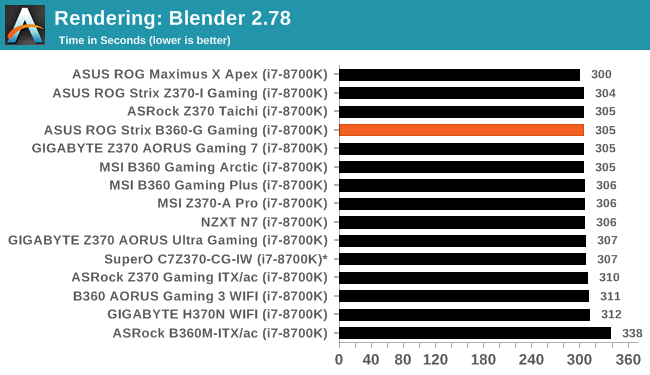
In our Blender tests, the ASUS ROG Strix B360-G Gaming's results were competitive with the majority of our results. This board ran the test without throttling we have seen on other B360 boards without changing power or current limits. Overall a solid showing here.
Rendering – POV-Ray 3.7: link
The Persistence of Vision Ray Tracer, or POV-Ray, is a freeware package for as the name suggests, ray tracing. It is a pure renderer, rather than modeling software, but the latest beta version contains a handy benchmark for stressing all processing threads on a platform. We have been using this test in motherboard reviews to test memory stability at various CPU speeds to good effect – if it passes the test, the IMC in the CPU is stable for a given CPU speed. As a CPU test, it runs for approximately 1-2 minutes on high-end platforms.
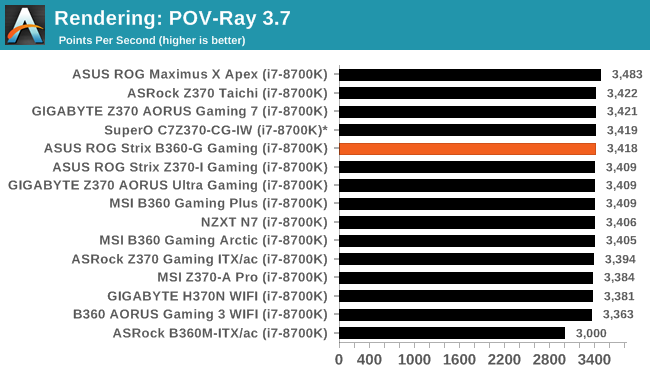
Our POV-Ray results show the B360-G gaming again mixing in with the other results.
Compression – WinRAR 5.4: link
Our WinRAR test from 2013 is updated to the latest version of WinRAR at the start of 2014. We compress a set of 2867 files across 320 folders totaling 1.52 GB in size – 95% of these files are small typical website files, and the rest (90% of the size) are small 30-second 720p videos.
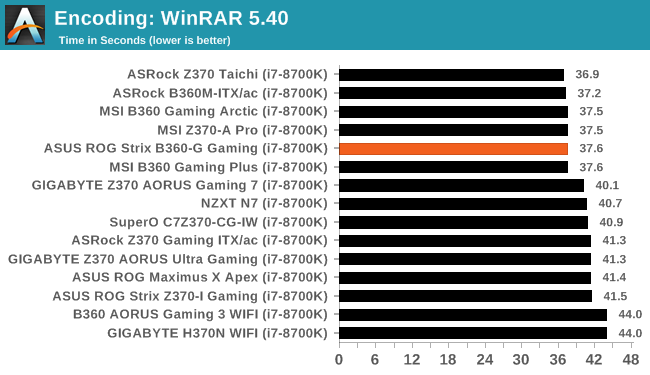
Moving on to WinRAR, here we see the board completing this benchmark in 37.6 seconds compared with the other boards in the graph.
Synthetic – 7-Zip 9.2: link
As an open source compression tool, 7-Zip is a popular tool for making sets of files easier to handle and transfer. The software offers up its own benchmark, to which we report the result.
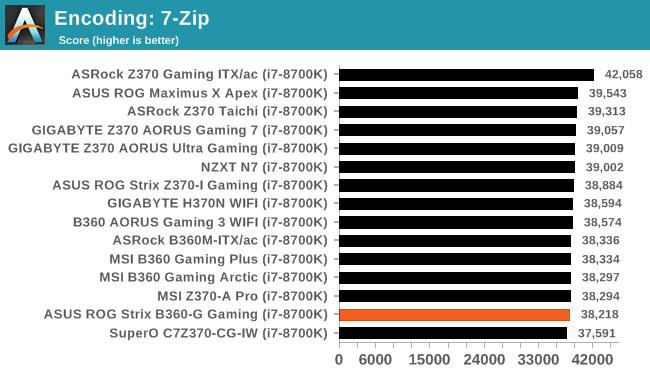
Our 7-Zip results show this tiny ASUS B360 board landing towards the bottom of the pack of some tight results. This isn't a concern as all results (sans first and last place) fall within a couple percent of each other.
Point Calculations – 3D Movement Algorithm Test: link
3DPM is a self-penned benchmark, taking basic 3D movement algorithms used in Brownian Motion simulations and testing them for speed. High floating point performance, MHz, and IPC win in the single thread version, whereas the multithread version has to handle the threads and loves more cores. For a brief explanation of the platform agnostic coding behind this benchmark, see my forum post here.
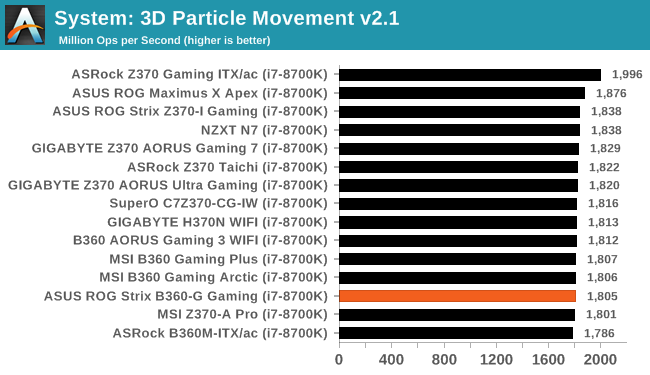
In 3D Particle Movement tests, the B360 towards the bottom of the results, but not by much. Removing the top result, an outlier, results are within 100 points from the 2nd place result and 50 points from a middling result. No issues here.
Neuron Simulation - DigiCortex v1.20: link
The newest benchmark in our suite is DigiCortex, a simulation of biologically plausible neural network circuits, and simulates the activity of neurons and synapses. DigiCortex relies heavily on a mix of DRAM speed and computational throughput, indicating that systems which apply memory profiles properly should benefit and those that play fast and loose with overclocking settings might get some extra speed up. Results are taken during the steady-state period in a 32k neuron simulation and represented as a function of the ability to simulate in real time (1.000x equals real-time).
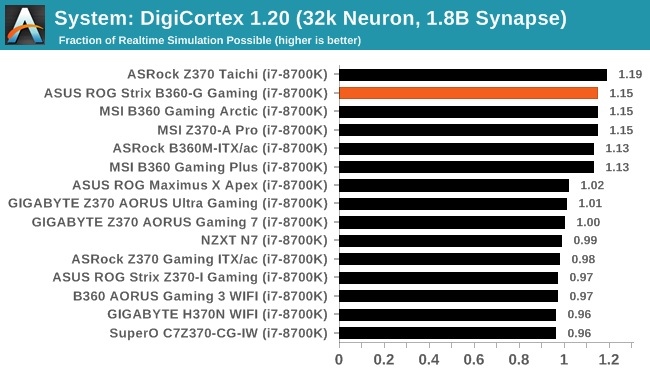
Last but not least, the DigiCortex results have the B360-G Gaming scoring 1.15 fractions of real-time simulation. This result has it mixing in nicely with our other datasets after the latest changes to the testing script. All good here as well.










26 Comments
View All Comments
Inteli - Tuesday, September 25, 2018 - link
And I thought the B450-F was a bit gaudy...at least the stenciling wasn't red and white.Besides that, I like seeing feature-rich boards at this price point. High-end Z370/X470 boards are overkill for a lot of builders who aren't going to do much (if any) overclocking, and low-end Z370/X470 boards tend to be fairly barebones. These upscale B360/B450 boards are great since you get quite a few features without having to pay for the overkill power delivery and SLI support you'll never use. AMD does it better IMO because B450 supports overclocking, so even without the best power delivery you couod still get a couple hundred megahertz overclock.
PeachNCream - Tuesday, September 25, 2018 - link
That is an obnoxious looking motherboard!vgray35@hotmail.com - Tuesday, September 25, 2018 - link
Inside a case, nobody sees it not even you, so really, who cares what it looks like. Performance and quality matter in my opinion, and gaudy stuff and lights only increases cost for zero gain.Inteli - Tuesday, September 25, 2018 - link
If the latest case trend weren't "Tempered Glass Everywhere", I might agree with you. However, these days seeing your motherboard inside your case is pretty common with custom PCs. Aesthetics have become an important part of PC building for some.PeachNCream - Tuesday, September 25, 2018 - link
I wouldn't bother with a case that has any sort of window. My preferred desktop would sit inside a ~$30, bargain bin Rosewill mATX tower so I'd never see it as vgray implies. Despite that, I saw the stupid text on the motherboard on the first page and I didn't even bother to care about how it stacked up on subsequent benchmarks. There are lots of functional alternatives that don't look as stupid so while performance matters, I can just buy something that doesn't look like a teenage boy's skateboard.Samus - Tuesday, September 25, 2018 - link
I'd never buy a case with a window. FCC regulatory failure aside, there will inevitably be EMI and\or RFI interference due to lack of shielding near the surface components (particularely videocards) that could result in anything from coil whine and output distortion to general stability issues.Ever notice every top PC OEM throughout history has never issued a mainstream model with a window? There is a good reason for that.
Inteli - Tuesday, September 25, 2018 - link
I get your point, but anecdotally I've personally never experience any instability because of a case window, and I can't recall anybody who has.I also don't know what you define as "mainstream", but both HP and Lenovo sell PCs with side windows. If by "mainstream" you mean "not gaming-branded", I can think of a number of good reasons why they wouldn't have windows, none of which have anything to do with EM or RF interference, or FCC compliance:
* Joe Schmoe doesn't care about what the inside of his computer looks like
* Increased manufacture cost, since the side panel requires more than "bend sheet metal"
* Mainstream computers aren't built to look good inside. All you'd really see would be air ducting.
erotomania - Wednesday, September 26, 2018 - link
dumbass...glass blocks EMI better...Bonge - Thursday, September 27, 2018 - link
No only if its Lead glass and shielding effiecincy will decrease with decreasing frequency,If you buy Lead glass expect a visit from government institutions like Homeland security FBI, etc. who would inquire as to what the freak you are using that for :))
speculatrix - Saturday, November 3, 2018 - link
Well done, @Bonge, for a measured response to @erotomania's rude ignorant/wrong comment.